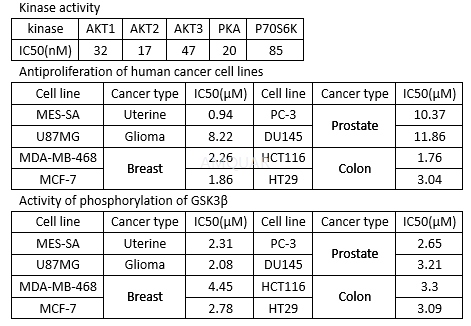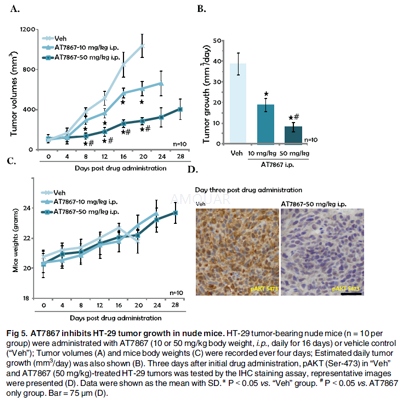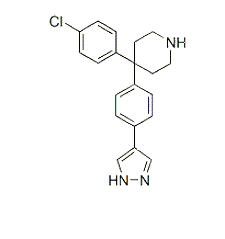-
生物活性
AT7867 is a potent ATP-competitive inhibitor of Akt1, Akt2 and Akt3 (IC50: Akt1= 32 nM, Akt2 = 17 nM and Akt3 = 47 nM). AT7867 inhibits structurally related AGC kinases p70S6K and PKA, and shows ATP-competitive activity to Akt2 with a Ki of 18 nM. AT7867 exhibits antiproliferation in cell lines with PTEN or PIK3CA mutations, and suppresses the cell growth of U87MG, PC-3 and DU145 cells. AT7867 suppresses Akt activity by inhibiting phosphorylation of GSK3β in human tumor cells, and induces the phosphorylation of the following Akt direct substrates including proapoptotic transcription factors FKHR (FoxO1a), FKHRL1 (FoxO3a) and the downstream target S6RP in U87MG cells.

-
体外研究
-
体内研究
15% Captisol, pH 9
-
激酶实验
In Vitro Kinase Assays[1]
Kinase assays for AKT2, PKA, p70S6K and CDK2/cyclinA were all carried out in a radiometric filter binding format. Assay reactions were set up in the presence of compound. For AKT2, the AKT2 enzyme and 25μM AKTide-2T peptide (HARKRERTYSFGHHA) were incubated in 20mM MOPS, pH 7.2, 25mM β-glycerophosphate, 5mM EDTA, 15mM MgCl2, 1mM sodium orthovanadate, 1mM DTT, 10μg/ml BSA and 30μM ATP (1.16Ci/mmol) for 4 hours. For PKA, the PKA enzyme and 50μM peptide (GRTGRRNSI) were incubated in 2mM MOPS, pH 7.2, 25mM β-glycerophosphate, 5mM EDTA, 15mM MgCl2, 1mM orthovanadate, 1mM DTT and 40μM ATP (0.88Ci/mmol) for 20 minutes. For p70S6K, the p70S6K enzyme and 25μM peptide substrate (AKRRRLSSLRA) were incubated in 10mM MOPS, pH 7, 0.2mM EDTA, 1mM MgCl2, 0.01% β-mercaptoethanol, 0.1mg/ml BSA, 0.001% Brij-35, 0.5% glycerol and 15μM ATP (2.3Ci/mmol) for 60 minutes. For CDK2, the CDK2/cyclinA enzyme and 0.12μg/ml Histone H1 were incubated in 20mM MOPS, pH 7.2, 25mM β-glycerophosphate, 5mM EDTA, 15mM MgCl2, 1mM sodium orthovanadate, 1mM DTT, 0.1mg/ml BSA and 45μM ATP (0.78Ci/mmol) for 4 hours. Assay reactions were stopped by adding an excess of orthophosphoric acid and the stopped reaction mixture was then transferred to Millipore MAPH filter plates and filtered. The plates were then washed, scintillant added and radioactivity measured by scintillation counting on a Packard TopCount. IC50 values were calculated from replicate curves using GraphPad Prism software. AKT1 and 3 enzyme assays were carried out at Invitrogen Ltd, while all other enzyme assays were performed at Upstate Biotechnology.
-
细胞实验
Cell Culture and Reagents[1]
All cell lines were purchased and grown in their recommended culture medium, which was supplemented with 10% fetal bovine serum (FBS) at 37°C in an atmosphere of 5% CO2and passaged for less than six months. AT7867 and LY294002 were dissolved to a 10mM stock in dimethyl sulphoxide (DMSO) while okadaic acid was dissolved to a 50mM stock in DMSO.
Alamar Blue Cell Proliferation Assay
Cells were plated in 96-well microplates at 5000 cells per well in medium supplemented with 10% FBS, and grown for 24 hours before treatment with AT7867. Inhibitor or vehicle control was added to the cells for 72 hours. Following this, Alamar Blue solution was added as stated in the manufacturer's instructions. The IC50 value for each inhibitor was calculated in GraphPad Prism using non-linear regression analysis and a sigmoidal dose-response (variable slope) equation.
Phospho-GSK3β (Serine 9) Cellular ELISA Assay
Cells were plated in 96-well microplates at 16,000 cells per well in medium supplemented with 10% FBS, and grown for 24 hours before treatment with AT7867. AT7867 or vehicle control were added to the cells for 1 hour. Following this, cells were fixed with 3% paraformaldehyde, 0.25% glutaraldehyde, 0.25% Triton-X100, washed and blocked with 5% milk in tris-buffered saline with 0.1% Tween-20 (TBST) prior to overnight incubation with a phospho-GSK3β (serine 9) antibody. The plates were then washed, secondary antibody added, and enhancement of the signal performed using DELFIA reagents as stated in the manufacturer's instructions. Europium counts were normalized to the protein concentration, and the IC50 value for each inhibitor was calculated in GraphPad Prism using non-linear regression analysis and a sigmoidal dose-response (variable slope) equation.

-
动物实验
In vivo tumor studies[2]
HT-29 cells were injected subcutaneous (s.c.) in the right flanks of female nude mice. Animals were randomized into three groups, and treatment was started with vehicle or AT7867 when established tumors were ~100 mm3in average volume. Control mice received vehicle only (10%
DMSO, 90% saline) and treatment mice received 10 or 50 mg/kg AT7867 intraperitoneally (i.p.). Tumor volumes and body weights were monitored every four days. The tumor size was calculated using the formula: V (volume) = 0.5328 × Long × Width × High (mm3). For recording mouse body weight, the estimated tumor weight (tumor volumes × 1g/cm3) was subtracted from total weight of each mouse. Mice were maintained under the following conditions: 12- hour dark/12-hour light cycle, 24±2oC temperatures, and 50±10% humidity. Mice were observed extremely carefully throughout the experimental period. The clinical signs of mice were recorded daily, and if the criteria of humane endpoints were met, animals were sacrificed. Humane endpoints were considered as rapid weight loss (>15%), abnormal changes in behavior and motion (social and eating behavior), tumor size greater than 2 cm3or skin problems (wounds or signs of inflammation). If animals reached these endpoints, they were euthanized by exsanguination under 2,2,2-tribromoethanol anesthesia (4 mg/10 g body weight). All injections in this study were performed. The protocol was approved by the Nanjing Medical University's Institutional Animal Care and Use Committee (IACUC) and Ethics Review Board (ERB).

-
不同实验动物依据体表面积的等效剂量转换表(数据来源于FDA指南)
|  动物 A (mg/kg) = 动物 B (mg/kg)×动物 B的Km系数/动物 A的Km系数 |
|
例如,已知某工具药用于小鼠的剂量为88 mg/kg , 则用于大鼠的剂量换算方法:将88 mg/kg 乘以小鼠的Km系数(3),再除以大鼠的Km系数(6),得到该药物用于大鼠的等效剂量44 mg/kg。
-
参考文献
[1] Grimshaw KM, Hunter LJ, Yap TA, et al. AT7867 is a potent and oral inhibitor of AKT and p70 S6 kinase that induces pharmacodynamic changes and inhibits human tumor xenograft growth. Mol Cancer Ther. 2010;9(5):1100-1110.
more
分子式
C20H20ClN3 |
分子量
337.85 |
CAS号
857531-00-1 |
储存方式
﹣20 ℃冷藏长期储存。冰袋运输 |
溶剂(常温)
|
DMSO
68 mg/mL |
Water
<1 mg/mL |
Ethanol
5 mg/mL |
体内溶解度
约10.5 mg/mL
-
Clinical Trial Information ( data from http://clinicaltrials.gov )
注:以上所有数据均来自公开文献,并不保证对所有实验均有效,数据仅供参考。
-
相关化合物库
-
使用AMQUAR产品发表文献后请联系我们




















